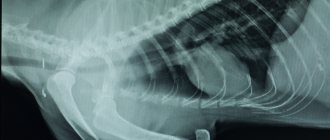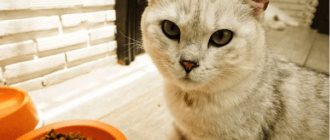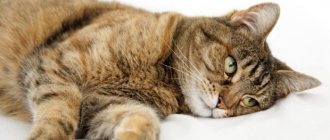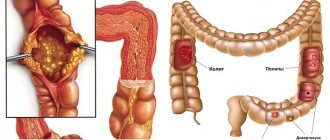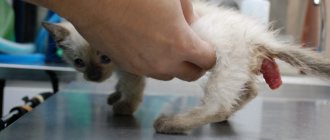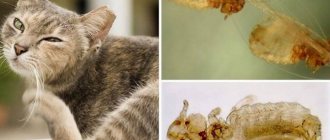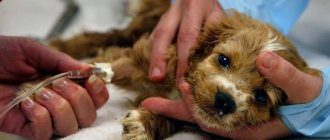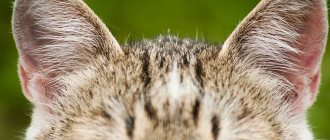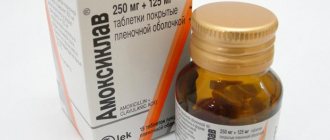Such a problem as intestinal inflammation in cats occurs quite often in veterinary medicine, and it can be triggered by several reasons. The pathology affects the small or large intestine or both sections at the same time. Depending on this, the symptoms of the sick animal will change. A responsible owner should immediately show the pet to a veterinarian if the slightest symptoms of deterioration in the pet’s condition appear. The sooner a diagnosis is made and appropriate treatment is started, the higher the likelihood that the cat’s health can be fully restored.
Functions of the intestines in the body
The way the intestines work affects all systems of the body. Each department performs its own functions.
Small intestine
He is responsible for:
- enzymatic breakdown of proteins, fats and carbohydrates. Moreover, a cat, unlike a dog, has its own peculiarity. Reduced amylase activity makes carbohydrate absorption less efficient. This is why you should not feed your cat ready-made dog food. A cat cannot go without food for a long time, but a dog eats up for two days beforehand;
- absorption of amino acids, fats and carbohydrates of feed into the blood;
- disinfection of microorganisms with the help of lymphoid elements that are secreted by the intestinal walls;
- production of biologically active compounds and hormones (serotonin, motilin, etc.).
Large intestine
Digestion of digestion products ends in the thin section. The cat’s large intestine is small, no more than 30 cm. This section no longer plays a role in digestion and absorption, it:
- absorbs water;
- releases decay products and unprocessed feed residues;
- forms fecal matter;
- carries out the act of defecation.
Failed therapy – checklist
Dietary aspects
- the diet should be selected individually for each cat, homemade diets are more preferable for the period of diagnosis, balanced diets are better for long-term use;
- sometimes you have to try several diets;
- the weekly diet should be adequately based on clinical response data in cats with IBD.
Glucocorticoids
- It is better to use prednisolone than prednisone;
- use budesonite if you are concerned about side effects;
- titrate the dose to the desired effect so as not to cause glucosuria;
- Will prednisolone be absorbed? It is worth considering the use of subcutaneous dexamethasone in cases of severe absorption.
Concomitant gastrointestinal diseases
- Are there any concomitant gastrointestinal diseases - cobalamin deficiency, parasites, undiagnosed lymphoma?
Diabetes
- Prolonged weight loss has been associated with new-onset diabetes—diabetes may occur with long-term use of glucocorticoids; ask owners to periodically check glucosuria with test strips.
Hyperthyroidism
- Is prolonged weight loss associated with newly diagnosed hyperthyroidism?
Pancreatitis
- often accompanies IBD in cats;
- diagnosed using ultrasound and IPL;
- Cats with anorexia are treated with subcutaneous fluids and analgesics.
Cholangeohepatitis
- often accompanies IBD in cats;
- diagnosed using an alkaline phosphatase test, ultrasound of the abdomen and liver biopsy;
- bile culture, treatment of infection;
- start treatment with ursodiol
What is inflammatory bowel disease
Intestinal inflammation begins with swelling of the villous epithelium that covers the mucous membrane. The secretory activity of the glands and motility changes. This in turn leads to a change in pH acidity and contributes to the transition of opportunistic microflora to pathogenic.
Violation of the composition of microorganisms leads to dysbacteriosis. The intestinal contents stop being absorbed and begin to decompose with the help of already pathogenic microflora. Toxic metabolic products (phenol indole) are absorbed into the blood, which leads to intoxication of the body.
Chronic form of inflammation
If acute inflammation is “treated”, the symptoms are eliminated, but the cause is not eliminated, the disease becomes chronic. In this case, the stage of remission alternates with exacerbation, and the clinical picture repeats from time to time.
Chronic enteritis and enterocolitis are recorded in:
- old animals;
- cats after suffering viral diseases;
- animals with low immunity;
- for diseases of the liver, heart and kidneys;
- with regular feeding disorders.
The acute form of enteritis is easily treatable (if it is not a viral pathology or poisoning). The owner calms down and the animal is supposedly healthy. However, you should carefully monitor the cat’s condition so as not to miss a relapse.
Diagnostics
To quickly diagnose the cause of intestinal inflammation in a pet, it is advisable for the owner to collect feces and vomit into clean bags or jars before going to the veterinary clinic. This is necessary so that a specialist can quickly examine them to identify parasites and toxic substances, as well as pathogenic bacteria.
You may be interested in: Urolithiasis in cats: causes and symptoms of the disease, treatment of pathology
In a veterinary clinic, the doctor will examine the cat and palpate the abdominal cavity. Further, if necessary, an ultrasound, x-ray and biopsy will be performed. Blood and urine tests are almost always necessary. If serious disorders in the colon are suspected, a colonoscopy is performed. An accurate diagnosis is made only after a complete examination of the animal.
The primary presumptive diagnosis is determined by the clinical picture and the results of testing for parasites. Treatment is also immediately carried out to eliminate dehydration and support the heart. In case of severe pain, anesthesia is performed using injections of an anesthetic or antispasmodic, depending on the picture.
It is important that the specialist immediately, upon first contact, determines whether the animal has poisoning, viral or bacterial infections, volvulus or intestinal obstruction. This is required, since the listed conditions pose a threat to the life of the cat if urgent treatment measures are not taken. If the condition is particularly severe, then first aid is combined with diagnostics at the same time. This allows you to quickly stabilize the animal and prevent the development of severe complications, including heart failure.
Reasons for the development of inflammatory processes
Intestinal inflammation can occur when:
- viral infection of the animal (coronavirus, acute viral gastroenteritis, feline panleukopenia);
- bacterial infection (salmonellosis);
- damage by protozoa (hemobartonellosis);
- helminthic infestation. Helminths have a mechanical (attached to the wall with suction cups and hooks, and also clog the lumen with their bodies) and chemical (release metabolic products into the intestine) effects;
- feeding poor quality food and water;
- sudden transition from one type of feeding to another;
- stressful situations (hypothermia, overheating).
There can be several causes of inflammation, and they are interconnected. For example, a cat was brought to the country, was not vaccinated, the type of feeding was changed, immunity dropped, but communication with relatives was added. The consequence is enteritis.
Major diseases
All diseases of the digestive tract are divided into infectious (colitis, coronavirus enteritis, gastritis) and non-infectious (constipation, cancer, intestinal obstruction, peptic ulcer, malabsorption syndrome). Let's take a closer look at each disease.
Colitis
Colitis is a disease characterized by inflammation of the large intestine. There are several reasons that lead to the development of the disease:
- Viral or bacterial inflammation.
- Parasitic infestations.
- Damage to the intestinal mucosa by a foreign body.
- Dietary disorder.
Clinically, colitis is manifested by local inflammation in the intestines (secretion of mucus and blood with feces, painful sensations) and intoxication syndrome (lethargy, refusal to eat and play, constant drowsiness).
Constipation
Constipation is a fairly common problem in cats. In this case, the pet rarely defecates; feces remain in the intestinal cavity for a long time and lead to intoxication.
Coronavirus enteritis
Coronavirus enteritis is an inflammation of the small intestine that occurs when exposed to a virus. The disease is infectious in nature and is transmitted by the fecal-oral route. A pet can become infected from sick cats that shed the virus in their feces. Kittens and older pets are more likely to get sick.
Gastritis
Gastritis is a disease characterized by inflammation of the gastric mucosa. The following reasons can lead to the development of gastritis:
- Poisoning (both chemicals and food).
- Dietary disorder (consumption of inappropriate foods).
- Hairball in the stomach.
- Taking certain medications.
- Allergic reaction.
Gastritis can occur in two forms: acute and chronic.
Bowel cancer
Colon cancer is uncommon in cats. It is a malignant tumor that is prone to unlimited growth and metastasis.
It is quite difficult to detect a tumor in the initial stage; most often it is an accidental discovery.
In the later stages, intestinal cancer is manifested by a significant decrease in body weight, lethargy, and apathy. Often, a cat is bothered by constipation and bleeding in the feces.
The prognosis in most cases is unfavorable, but depends on the detected stage and nature of the tumor.
Obstruction
Intestinal obstruction is an acute emergency pathology that, if not intervened in time, leads to death.
Something else interesting: Rules for choosing a veterinary clinic
The reasons that lead to the development of obstruction are as follows:
- foreign body;
- intussusception;
- adhesive disease;
- compression by tumor.
The disease can occur in two forms: complete or partial obstruction. Symptoms appear acutely: paroxysmal pain, vomiting, lack of passage of stool and gas.
Peptic ulcer
Peptic ulcer is a pathology of the stomach or duodenum in which ulcers form on the mucous membrane.
There are several reasons why the disease may develop:
- Infectious agents (including helminths).
- Taking certain medications.
- Reduced protective properties of the mucous membrane.
Peptic ulcer disease is a chronic disease, so periods of exacerbation alternate with periods of remission. All symptoms appear in the acute phase: severe pain, signs of gastrointestinal bleeding (vomiting “coffee grounds”, blood in the stool).
Malabsorption
Malabsorption is a condition characterized by impaired absorption of nutrients in the intestine. Malabsorption can occur for several reasons:
- Impaired secretion or function of digestive enzymes (diseases of the pancreas, gall bladder).
- Malabsorption in the small intestine (enteritis).
- Dysbacteriosis.
Clinically, malabsorption is manifested by prolonged diarrhea (sometimes foamy), an increase in the volume of excreted feces, weight loss (due to insufficient intake of nutrients), signs of hypoproteinemia and hypovitaminosis.
Symptoms and first signs of intestinal inflammation in a cat
It is customary to talk about enteritis when unformed fecal masses appear. Typically, the masses are:
- thin or watery;
- mushy;
- mixed with mucus and blood;
- black or dark brown;
- fetid, unpleasant, putrid odor.
The absence of fecal matter or alternating constipation and diarrhea is also a typical sign of enterocolitis. If a cat is used to going to the litter box or asks to go outside, then if the intestines are inflamed, she may not have time to “orient herself” and the owner will notice this.
Treatment regimen
The effectiveness of therapeutic manipulations will depend on the timely elimination of the cause. If the cause is not clear, the diagnosis is established only by signs, there is no time to waste (especially if enteritis in kittens).
Clinical and laboratory tests can last up to 3 days. They must be started immediately, but waiting for results can be fatal. To avoid complications with enteritis, the following treatment regimen is used:
- The cat is given a starvation diet. During this period, the animal does not want to take food, do not force it;
- if the animal exhibits pain and tenesmus (the urge to defecate) is detected, then painkillers are used;
- pathogenic microflora needs to be suppressed and broad-spectrum antibiotics come to the rescue;
- if diarrhea has progressed to the stage of profuse diarrhea (only water is poured out), it is necessary to restore the water balance.
If it is possible to culture the tank to identify an antibiotic sensitive to microflora, then the material is first selected and only then a broad-spectrum antibiotic is used.
How to act as an owner
If you notice symptoms of intestinal damage in your cat, you should contact your veterinarian for medical help. It is quite difficult to determine on your own what kind of disease your pet has and prescribe the appropriate treatment. The veterinarian will carefully examine the pet, prescribe additional examinations, and make a diagnosis. And only after this it will be possible to determine which medications are indicated for the cat. In some cases, surgery is necessary.
If your cat has severe vomiting and diarrhea, it is necessary to protect it from dehydration before contacting a veterinarian. To do this, let your cat drink in small portions, but often.
List of drugs and antibiotics
If there is a need for painkillers, the following can be used:
- No-Spa 1/10 tablet 2 times a day on the root of the tongue;
- Baralgin 1/10 tablets;
To restore water balance in a cat’s body, you can use the following medications:
- Gempogel at the rate of 1 ml per kg of animal weight 3 times a day;
- EnteroZoo 1/2 teaspoon 2 times a day;
- Lagnitin 1/2 tablet per 2 kg of cat’s weight;
- Polysorb VP 0.05 g per kg of animal weight.
- “Regidron”, “Enterosgel”, “Smecta”, etc. are quite suitable.
Antibiotics:
- Clamoxil (analogues of amoxisan, amoxiclav, amoxicillin) intramuscularly 1 ml of the drug per 10 kg of cat weight or 1/6 tablet per 5 kg of weight;
- Levomycetin. For a cat weighing 5 kg, 1/10 tablets 3 times a day;
- Enrofloxacin (Enromag). Intramuscularly 3-5 thousand units per kg of animal weight.
Rules for deworming cats
Deworming of cats should be carried out:
- prophylactically;
- regularly;
- quarterly.
To carry out the procedure, preference should be given to complex preparations. These drugs usually contain two active ingredients. Once absorbed, they will act simultaneously on both flatworms and roundworms.
The following drugs have proven themselves to be the most effective:
- Azipirin;
- Febtal combo;
- Milbemax;
- Dirofen;
- Drontal.
Using the listed remedies there is no need for laxatives and preliminary preparation of the body (starvation diet).
When planning to carry out deworming, you should take into account that there are physiological periods during which the use of drugs is not contraindicated, but is not advisable, these are:
- pregnancy;
- lactation;
- stressful situations.
Diet and feeding ration
At the first sign of enteritis, do not feed the animal. A fasting diet makes it possible to free the gastrointestinal tract from everything unnecessary.
Do not limit the watering hole. Next to the water you can place a bowl of whey or yogurt, kefir.
The following will be beneficial for your cat's intestines:
- milk jelly;
- decoction of flax seeds. To ½ cup of decoction you can add 1 drop of alcohol tincture of iodine (until a bluish color), it will help carry out bactericidal treatment.
If your appetite returns, start with fermented milk feeds:
- curdled milk;
- kefir;
- fresh sour milk cheese.
Next, gradually introduce into your diet:
- chopped meat;
- minced fish;
- eggs.
Prevention measures
Vaccination will provide immunity against viral infection. Modern vaccines allow you to be vaccinated against several diseases at once - take advantage of them. This is especially true for an animal that “walks on its own” or travels, for example, to the country.
- You can protect yourself from bacterial infection by not allowing poor quality food into your diet. If meat can be fed raw, fish and offal should be cooked for at least 30 minutes.
- Do not buy meat and fish of questionable origin, as well as meat trimmings and slaughterhouse waste.
- To protect your cat from helminths, carry out preventive deworming.
- Avoid stressful situations.
How does a species-typical diet help with gastrointestinal diseases?
Biologically appropriate cat food includes raw meat, organ meats, liver, small amounts of vegetables and bone. These are the main components of a healthy diet. The cat's body is designed to obtain the necessary nutrients and energy from animal protein. It is easily digestible and does not burden the kidneys, liver and other organs. A healthy diet should contain about 70%-75% liquid.
Gastrointestinal diseases in cats can be caused by disturbances in the microflora of the stomach. A varied, species-typical diet will help keep the microflora healthy. A healthy gastrointestinal environment protects cats from pathogenic bacteria and parasites and ensures stable, strong immunity.
A healthy diet is not only a means to combat gastrointestinal problems. Species-typical nutrition is an excellent and affordable way to prevent gastrointestinal diseases in cats. SUPERPET will help provide your cat with a biologically appropriate diet. The composition contains only natural ingredients. SUPERPET diets contain the required amount of fluid, enough taurine and all the vitamins and minerals needed for health. The food is stored and delivered frozen, so you can be sure that there are no preservatives in it. Help your pet eat right - this will keep him healthy and ensure a long and happy life.
